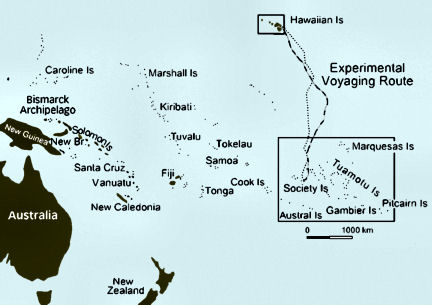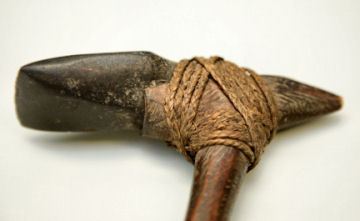A Long Haul
A new study of stone tools suggests that ancient Polynesian sea voyagers traveled thousands of miles in their canoes.
By Emily Sohn
Long before the invention of cars, planes, or motorboats, people were exploring the globe. Some of these travelers undertook trips of thousands of miles across oceans. Starting about 4,000 years ago, for example, courageous mariners settled the islands of East Polynesia in the Pacific Ocean.
A new study emphasizes the impressive skills of those Polynesian seafarers. About 1,000 years ago, the study suggests, explorers traveled by canoe from Hawaii to islands that were more than 4,000 km (2,500 miles) south. In their boats, they carried rocks for tool making.
 |
|
This map shows the Polynesian Islands, with the eastern islands contained in a box. The dotted line traces the 1976 route of a Polynesian-style canoe that made a round trip between Hawaii and Tahiti. |
| Science |
According to legends recounted by today’s Polynesian islanders, their ancient ancestors built canoes with sails in which they sailed south from the Hawaiian islands to Tahiti. From there, the legends continue, the sailors traveled east to the Tuamotu Islands.
To find out whether those legends were true, researchers from the University of Queensland in St. Lucia, Australia, studied 19 stone tools that had been found in the Tuamotu Islands.
The tools that they examined are called adzes. They are made from basalt, a volcanic rock. An adze, like a garden hoe, has a stone blade attached to the end of a long wooden handle. It’s used to cut wood.
 |
|
Polynesians used adzes such as this one. The tools, which are made of stone and wood, helped scientists track the paths taken by seafarers some 1,000 years ago. |
| J. Willcock/Anthropology Museum, University of Queensland |
The researchers also studied volcanic rock from 28 sources in Polynesia. The rocks at each site have a unique chemical composition. So, the scientists used chemistry to classify rocks by their origins.
When the Australian scientists compared the Polynesian stone tools with the rocks they had classified, they found that all but one came from nearby island groups. The chemical composition of the remaining tool pointed to an origin in Hawaii.
To sail from Hawaii to Tahiti, the Polynesians probably passed through the Tuamotus, the researchers say. The currents and winds make that a good route. Also, the scientists say, the Tuamotus and the nearby Society Islands “could be approached from all quarters and were thus probably important in Polynesian trade.”
In 1976, archaeologist Ben Finney of the University of Hawaii in Honolulu showed that such a trip was possible. He and his colleagues built a canoe for long-distance traveling in the ancient Polynesian style. It was 19 meters (62 feet) long and had two masts for sails.
It took the scientists 2 months to sail the canoe from Hawaii to Tahiti and back. The modern voyagers passed through the Tuamotus on the way. Their trip, they said, proved that people long ago could have traveled long distances over the open sea to settle Polynesia.
Those ancient canoeists probably passed down their knowledge through the generations until about 550 years ago, the researchers say. That’s when sea travel through East Polynesia seemed to have stopped.
Earlier this year, an analysis of unearthed chicken bones led another group of scientists to conclude that Polynesian sailors reached what is now Chile by about 620 years ago. The discovery of Polynesian basalt adzes in South America would strengthen that argument.—Emily Sohn
Going Deeper:
Bower, Bruce. 2007. Sail away: Tools reveal extent of ancient Polynesian trips. Science News 172(Sept. 29):198. Available at http://www.sciencenews.org/articles/20070929/fob7.asp .
Sohn, Emily. 2007. Chicken of the sea. Science News for Kids (June 13). Available at http://www.sciencenewsforkids.org/articles/20070613/Note2.asp .







